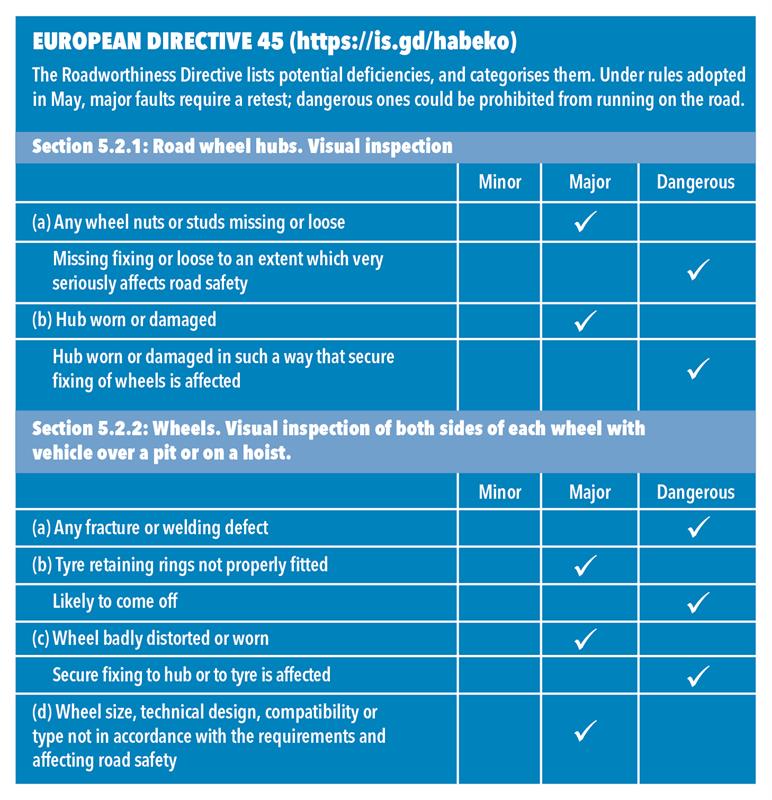From a mechanical engineering perspective, the way wheel rims attach to hubs is flawed, contends Gary Broadfield, technical director of Wheely-Safe, which markets a wheel loss early-warning system. He explains: “If someone was given the task today of designing a way of fixing a wheel to the end of an axle, they wouldn’t choose to do it with 10 studs and nuts. The clearances that exist to allow studs and rim holes to easily line up are very large. This means there is potential for movement. You rely on nut heads and sufficient torque to hold the wheel in place.
“But thermal expansion, vibration, axial forces and the fact that, as the heavily-loaded wheel rotates, those forces load one or two studs in sequence rather than all 10 simultaneously, mean that the generous tolerances result in a less-than-ideal mechanical set-up.”
The only way to prevent movement is to apply very high levels of torque to the nuts, but this can overload the studs, leading to stress fractures, because the mating surfaces on a conventional wheel are comparatively small, adds Broadfield. He says that a better design is employed in Formula 1 cars, in which wheels fasten on to hubs using a single large nut. That allows for much smaller tolerances and provides a greater mating surface.
Poor maintenance is the root cause of wheel rim failures, according to the technical director. “Dirty or rusted mating surfaces mean that as wheel nuts are tightened, they soon lose torque, due to grit or rust between the surfaces. Inevitable movement over time results in the stud holes in the rim elongating, and the studs will wear and weaken. This magnifies the problem. It can also lead to stress fractures around the bolt holes. If a driver hits a kerb with sufficient force, this can snap a stud, which places additional stress on the remaining ones. This rapidly accelerates the wheel loosening process.”
Cases of dirt and corrosion between the hub and main face of the wheel, or incorrect torqueing that leads to the loosening of a wheel, are regularly seen by Simon Wayne, technical support engineer at tyre and tyre service provider ATS Euromaster. Non-compliance with manufacturers’ recommendations for lubrication and sequence tightening is also common. A frequent, but little publicised, cause of wheel loss is tampering, he adds, where a thief has attempted to steal the wheel.
“Wheel security begins before you touch a single nut,” he continues. “A visual inspection of the wheel and the exposed stud ends for corrosion is import to prevent stripping the threads when the nut is removed. Wheels must be lifted over the studs to prevent damaging them. We inspect the wheel and hubs for damage, which will occur if a wheel has become loose, and we check the top of wheel arches to ensure no debris can drop down on to the mating surfaces. We always torque wheel nuts by hand; never with an air tool.”
Wayne says rims could be damaged by heat generated by running on an under-inflated tyre, or a faulty brake. Over time, extreme heat will deform the wheel. Some manufacturers place heat-sensitive stickers on wheels that, once discoloured, mean the wheel rim must be scrapped (such as Alcoa; see also links below). A deformed rim makes a blow-out more likely, as it can allow the tyre bead to pop over the flange.
“Wheel security has been our main focus, for several years,” he explains. “We have our own policies on wheel security for van and truck, and in February we trained every technician in the company face-to-face on wheel security issue recognition.” He adds that it has also introduced a vehicle off road policy for wheels in a dangerous condition.
Wayne concludes: “Lack of awareness about wheel maintenance is ATS Euromaster’s biggest concern. Drivers generally only look at a tyre when they do their walk-round check. After all, it’s the thing most likely to fail. Drivers don’t look at the wheel itself and don’t know what the tell-tale signs of a potential problem are. We believe there should be a greater focus on training drivers to spot problems at an early stage.”
Free wheel security advice
IRTE/FTA wheel security guidance – https://is.gd/hadiwe – gives advice on wheel fitment and maintenance, protective equipment and more.
 ROADWORTHINESS DIRECTIVE
ROADWORTHINESS DIRECTIVE
On 20 May, the latest incarnations of the 2014/45/EU (Periodic) and 2014/47/EU (Roadside) Roadworthiness Directives were adopted. But according to commercial vehicle wheel distributor MWheels (formerly Motor Wheel Service Distribution), the UK’s testing and compliance regime does not reflect newly imposed EU Directives.
MWheels’ COO, Matt Mardle, explains: “Wheels have been a commodity item and not deemed safety critical. That meant anyone could fit any wheel onto their vehicle. What we have lobbied for is for it to be mandated that wheels are fit for purpose. This means knowing how it was manufactured, its provenance, that it is correctly marked and meets OE specification and recognised standards.”
As Mardle points out, the EU Directive [45]’s section on wheels states: ‘Compatibility between parts and components, such as between wheels and wheel hubs, should be treated as a critical safety item and should be checked during roadworthiness testing.’ Additional legislative text includes several visual wheel inspection prerequisites (see box) and confirmation that wheel security is a serious matter.
Following meetings with the DfT, MWheels says it will work with it to look at ways in which the heavy goods vehicle inspection manual’s section on wheels can be enhanced to improve safety. It advocates a 10-point annual inspection checklist (see link).
FURTHER INFORMATION
Heat-sensitive labels – https://is.gd/pukijo
MWheels white paper – https://is.gd/kitopu